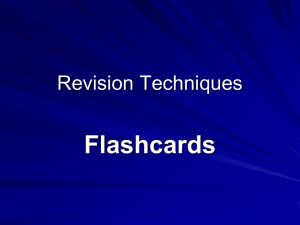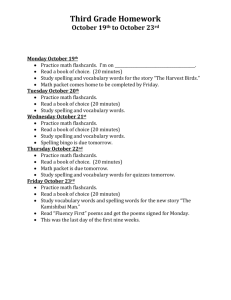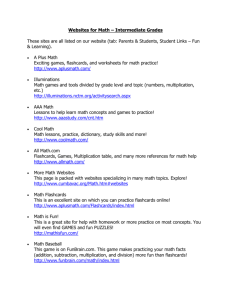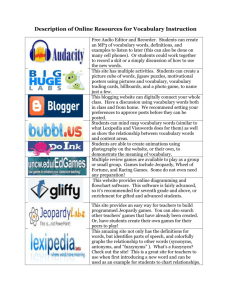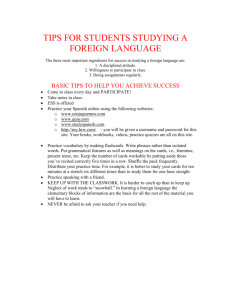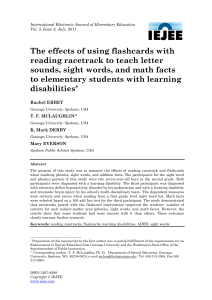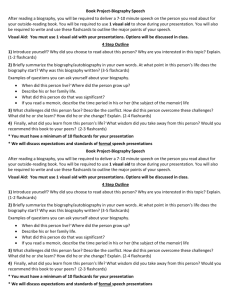the effects of reading racetracks and flashcards on sight word
advertisement
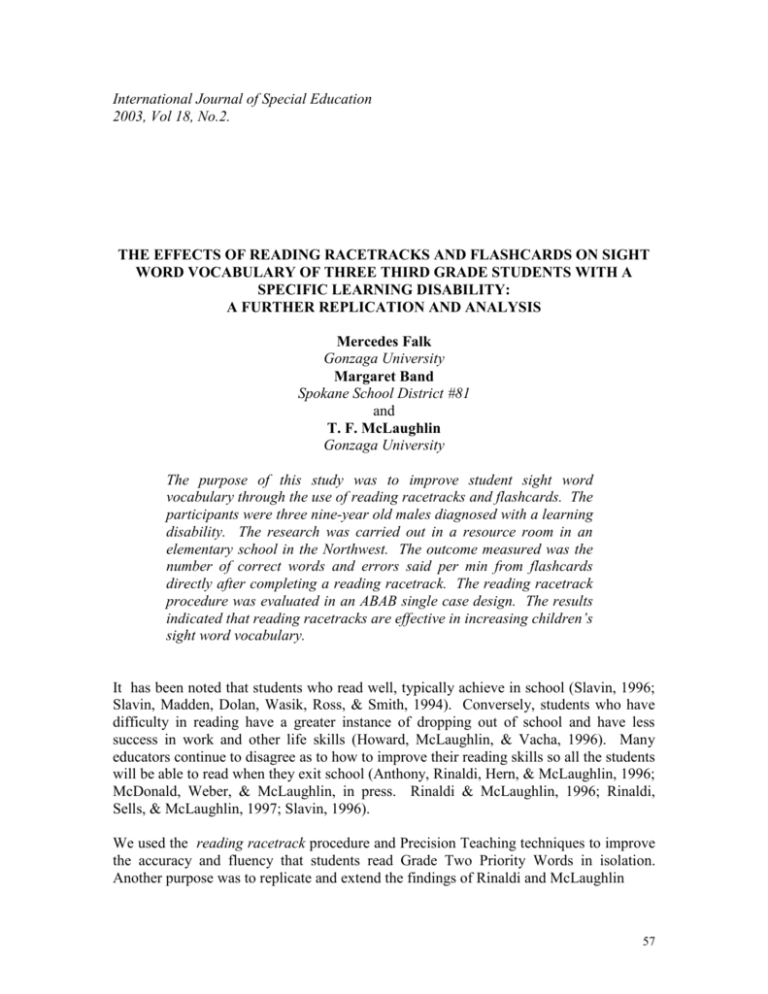
International Journal of Special Education 2003, Vol 18, No.2. THE EFFECTS OF READING RACETRACKS AND FLASHCARDS ON SIGHT WORD VOCABULARY OF THREE THIRD GRADE STUDENTS WITH A SPECIFIC LEARNING DISABILITY: A FURTHER REPLICATION AND ANALYSIS Mercedes Falk Gonzaga University Margaret Band Spokane School District #81 and T. F. McLaughlin Gonzaga University The purpose of this study was to improve student sight word vocabulary through the use of reading racetracks and flashcards. The participants were three nine-year old males diagnosed with a learning disability. The research was carried out in a resource room in an elementary school in the Northwest. The outcome measured was the number of correct words and errors said per min from flashcards directly after completing a reading racetrack. The reading racetrack procedure was evaluated in an ABAB single case design. The results indicated that reading racetracks are effective in increasing children’s sight word vocabulary. It has been noted that students who read well, typically achieve in school (Slavin, 1996; Slavin, Madden, Dolan, Wasik, Ross, & Smith, 1994). Conversely, students who have difficulty in reading have a greater instance of dropping out of school and have less success in work and other life skills (Howard, McLaughlin, & Vacha, 1996). Many educators continue to disagree as to how to improve their reading skills so all the students will be able to read when they exit school (Anthony, Rinaldi, Hern, & McLaughlin, 1996; McDonald, Weber, & McLaughlin, in press. Rinaldi & McLaughlin, 1996; Rinaldi, Sells, & McLaughlin, 1997; Slavin, 1996). We used the reading racetrack procedure and Precision Teaching techniques to improve the accuracy and fluency that students read Grade Two Priority Words in isolation. Another purpose was to replicate and extend the findings of Rinaldi and McLaughlin 57 INTERNATIONAL JOURNAL OF SPECIAL EDUCATION Vol 18, No.2. (1996). In the present replication a more rigorous experimental design than Rinaldi and McLaughlin (1996) was used to determine if the use of reading racetracks could increase correct rate and decrease errors for words read in isolation and flash cards were added. The final purpose of this study was to see if using reading racetracks on a daily basis improved student sight word vocabulary for three students identified with learning disabilities. Data were collected on a loose-leaf paper while the students read their racetrack and flashcards. These data were later transferred onto a raw data collection sheet. Method Participants and Setting There were three participants in the study. Taylor, Bobby, and Daniel were nine- yearold males all diagnosed with a specific learning disability. Their reading levels were all at least a year below their current grade level. Taylor and Bobby received services for thirty minutes of reading right before lunch and thirty minutes of math right after lunch. They also both received in-class services. Daniel received services for written language and reading for one hour at the end of the school day. The research took place in the special education resource room. The resource room was housed in an elementary school in a large urban setting in the Pacific Northwest. The school was located in a low socioeconomic area where over 70% of the students qualified for free and reduced lunch. The data for Taylor and Bobby was gathered both immediately before and after lunch, depending on what the students needed to get completed that day. When these data were collected, there were two adults and three to seven other kids in the room. The data for Daniel were gathered with only the first author during the last 15 minutes of the school day. Dependent variables and Measurement Procedures The dependent variable measured was the number of words on flashcards said correctly in a one-minute timing. During both baseline phases, the students read words on flashcards that were new to them. While they read the words, corrects and errors were recorded for one minute. There were two sessions in the second baseline. In the first session, the students read the flashcards from the first intervention without doing the racetrack. In the second session, the students read their new set of words without doing the racetrack. During intervention, they did the racetrack for a one-minute timing and an error drill on the words they missed. Immediately following, they read the same flashcards they did for baseline while corrects and errors were measured again. The same procedure was followed for the second intervention. Experimental Design and Condition An ABAB single case replication design (Kazdin, 1982) was employed to evaluate the effectiveness of the Reading Racetracks Procedure. Baseline 1 and 2. During baseline, students were timed for one minute on flashcards based on words that were not in their immediate sight word vocabulary. The first baseline was in effect for three days with flashcards the students did not practice. The 58 INTERNATIONAL JOURNAL OF SPECIAL EDUCATION Vol 18, No.2. second baseline was in effect for two days. On the first day, the students read the flashcards from their first baseline and intervention and on the second day, they read a new set of flashcards that included the words on their new racetrack. Reading Racetracks and Flash Cards 1 and 2. Students were told the words that they missed during the racetrack. The researcher pointed to the word again and asked what word? After that was done with every word, the researcher randomly pointed to all words missed and asked the child to say them until firm. The second reading racetrack and flash card phase followed the same procedures as the first intervention, except new words were used on the racetrack and the flashcards. Reliability. Reliability of measurement was taken once during each phase change. The resource room teacher recorded number of corrects and errors during the one-minute flashcard drill the same time the researcher did. Every phase, but the second baseline had 100% reliability. The researcher and observer were off on just one word on the first day of the second baseline for Taylor. Results For Taylor, the mean correct rate during baseline-1 was 9 with a range of 8-11. The mean correct rate during the first reading racetracks and flashcards was 28.8 with a range of 9-46. The mean correct rate during baseline-2 was 17.5 with a range of 7-28. The mean correct rate during the second reading racetrack and flashcard phase was 30.714 with a range of 21-44. For Taylor, the mean error rate during baseline-1 was 12 with a range of 10-16. The mean error rate for the first reading racetracks and flashcards was 4.5 with a range of 0-11. The mean error rate during baseline-2 was 4.0 with a range of 0-8. The mean error rate for the second reading racetrack and flashcard phase was 1.0 with a range of 0-4. For Bobby, the mean correct rate during baseline-1 was 5.3 with a range of 4-6. The mean correct rate during the first reading racetracks and flashcards was 19.625 with a range of 10-33. The mean correct rate for baseline-2 was 18 with a range of 8-28. The mean correct rate during the second reading racetrack and flashcard phase was 27.56 with a range of 20-35. For Bobby, the mean error rate during baseline-1 was 5.0 with a range of 3-6. The mean error rate for the first reading racetracks and flashcards was 1.428 with a range of 0-3. The mean error rate for baseline-2 was 2.0 with a range of 0-4. The mean error rate for the second reading racetrack and flashcard phase was .222 with a range of 0-1. For Daniel, the mean correct rate during baseline-1 was 7.66 with a range of 3-11. The mean correct rate during the first reading racetracks and flashcards was 33.71 with a range of 21-41. The mean correct rate for baseline-2 was 16.5 with a range of 10-23. The mean correct rate during the second reading racetrack and flashcard phase was 28 with a range of 20-44. The mean error rate fir Bobby for baseline-1 was 8.33 with a range of 7-9. The mean error rate for the first reading racetracks and flashcards was 3.143 with a range of 2-6. The mean error rate for baseline-2 was 2.0 with a range of 159 INTERNATIONAL JOURNAL OF SPECIAL EDUCATION Vol 18, No.2. 3. The mean error rate for the second reading racetrack and flashcard phase was 1.148 with a range of 2-0. Discussion This study showed that the reading racetrack is and remains an effective in improving fluency of sight words for the three students with mild disabilities. Our participants improved their sight words by doing reading racetracks and the flashcards together. They enjoyed being timed and seeing how many words they could say correctly in a minute. Each student improved in their corrects and errors. Although some students’ improvements were greater than others, they all gained fluency. Taylor improved from 8 words correct per minute to 44 and from 16 errors per minute to 0. Bobby improved from 3 words correct per minute to 35 and from 6 errors per minute to 0. Daniel improved from 3 words correct per minute to 44 and from 9 errors per minute to 0. On the last session, each student had a big jump in their corrects and they all had zero errors. The significant improvement can be attributed to the fact that the students had a fourth grade partner to whom they read the racetrack and the flashcards. In each of the previous sessions, they all worked with the researcher one on one. The first author felt the new situation with the chance to impress their older peers helped them excel. Those final results show that the reading racetrack can be a good motivator, especially when said to their peers. Another aspect of this program that makes reading racetracks very attractive and practical is the fact that after the initial session, subsequent daily sessions were easy to implement, manage, and carry out. This was also found in our first study (Rinaldi & McLaughlin, 1996), and in an additional replication (Anthony et al., 1997). It is also our opinion that this program in conjunction with classwide peer tutoring (CWPT) (Greenwood, Delquadri, & Carta, 1988) or flashcards could offer individualized instruction for an entire classroom in less than 10 minutes of daily classroom time. One could employ reading racetracks rather than the forms that Greenwood et al., (1988) use. This could also be true for the forms that support for spelling and math facts. This could be especially valuable in grades one and two when students are expected to learn and remember sight words that do not follow the phonetic rules. The use of flashcards was also easy to implement in the classroom setting. Stone, McLaughlin, and Weber, (2002)have urged the use of flash cards to assist students in various academic disciplines. The combining of reading racetracks with flash cards appears to also be a fruitful area for future classroom research. References Anthony, C., Rinaldi, L., Hern, C., & McLaughlin, T. F. (1997). Reading racetracks: A direct replication and analysis with three elementary students. Journal of Precision Teaching and Celeration, 14(2), 31-36. Greenwood, C. R., Delquadri, J. C. Carta, J. J. (1988). Classwide peer tutoring (CWPT). Seattle, WA: Educational Achievement Systems. Howard, V. F., McLaughlin, T. F., & Vacha, E. F. (1996). Educational capital: A 60 INTERNATIONAL JOURNAL OF SPECIAL EDUCATION Vol 18, No.2. proposed model and its relationship to academic and social behavior of students at risk. Journal of Behavioral Education, 6, 135-152. O'Donnell, P., Weber, K. P., & McLaughlin, T. F. (in press). Improving correct and error rate and reading comprehension using key words and previewing: A case report with a language minority student. Education and Treatment of Children. Rinaldi, L., & McLaughlin, T. F. (1996). The effects of reading racetracks on the fluency of see-to-say words in isolation by a student with learning disabilities. Journal of Precision Teaching and Celeration, 13(2), 44-52. Rinaldi, L., Sells, D., & McLaughlin, T. F. (1997). The effects of reading racetracks on sight word acquisition of elementary students. Journal of Behavioral Education, 7, 219234. Slavin, R. E. (1996). Education for all. Exton, PA: Swets. Slavin, R. E., Madden, N. A., Dolan, L. J., Wasik, B. A., Ross, S. M., & Smith, L. J. (1994). Whenever and where ever we choose: Replication of success for all. Phi Delta Kappan, 75, 639-647. Stone, S., McLaughlin, T. F., & Weber, K. P. (2002). The use and evaluation of copy, cover, and compare with rewards and a flash cards procedure with rewards on division math facts mastery with a fourth grade girl in a home setting. International Journal of Special Education, 17(2), 82-91. 61

